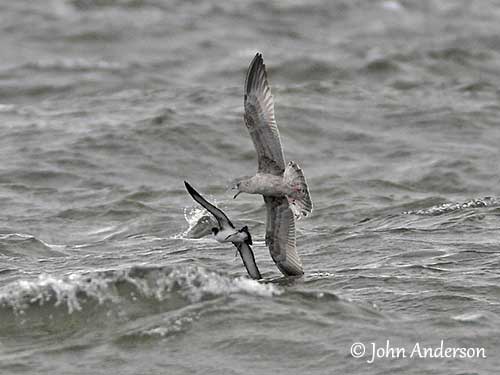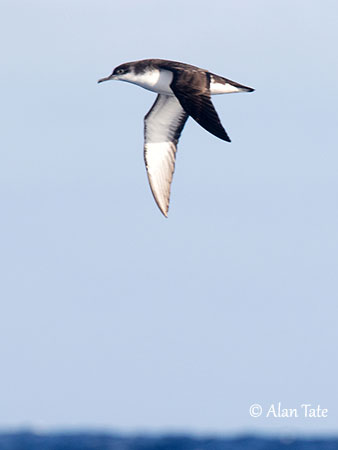
PROTECTION / THREATS / STATUS:
The Manx Shearwater is threatened by introduced and invasive species such as pigs, cats and rats on the breeding islands. The legal harvest kills 1,000/5,000 chicks every year. Oil spills, marine pollution, fishing nets and wind-farms also affect this species.
The size of the population is unknown but in Europe (95% of the breeding range) the numbers were roughly estimated at 684,000/785,000 mature individuals in 2015.
The population trend is decreasing in North America, but the trend is unknown in Europe.
The Manx Shearwater is not considered globally threatened. Several breeding islands are now protected and the invasive species are regularly controlled. The species is currently evaluated as Least Concern.
Fr: Puffin des Anglais
Ang: Manx Shearwater
All: Atlantiksturmtaucher
Esp: Pardela Pichoneta
Ita: Berta minore atlantica
Nd: Noordse Pijlstormvogel
Sd: mindre lira
Photographers:
John Anderson
John Anderson Photo Galleries
Alan & Ann Tate
AA Bird Photography
Ingo Waschkies
Bird Photography
Text by Nicole Bouglouan
Sources:
HANDBOOK OF THE BIRDS OF THE WORLD vol 1 by Josep del Hoyo-Andrew Elliot-Jordi Sargatal - Lynx Edicions - ISBN: 8487334105
OISEAUX DE MER – Guide d’identification de Peter Harrison – Editions Broquet (Canada) – ISBN-10 : 2890004090 – ISBN-13 : 978-2890004092
THE HANDBOOK OF BIRD IDENTIFICATION FOR EUROPE AND THE WESTERN PALEARCTIC by Mark Beaman, Steve Madge - C.Helm - ISBN: 0713639601
ANIMAL CORNER - Manx Shearwater Bird
Skomer Island - Manx Shearwater Factsheet
BBC News - Manx shearwater: The Skomer bird which appears after dark
Game & Wildlife Conservation Trust
Wikipedia, the free encyclopaedia
Manx Shearwater
Puffinus puffinus
Procellariiformes Order – Procellariidae Family
INTRODUCTION:
The Manx Shearwater of the family Procellariidae is a bird of the open sea. The long, narrow wings and the feet placed far back on the body are well-adapted tools for swimming. However, the bird is not able to walk easily on land where it comes for nesting, and becomes an easy prey for introduced predators and gulls. For this reason, it nests in burrows and is active only at night. It breeds in colonies where the birds become very noisy after dark.
The Manx Shearwater is found in the Atlantic Ocean. It breeds from N Atlantic Ocean to the Azores, Canary Islands and Madeira. It migrates southwards after breeding to spend the winter off Brazil and Argentina, and in smaller numbers off SW South Africa.
The Manx Shearwater is not globally threatened, although the invasive species are the main threat on the nesting areas. Marine pollution, oil spills, fishing nets and collisions with wind farms also affect the species.

DESCRIPTION OF THE BIRD:
Biometrics:
Length: 31-36 cm
Wingspan: 76-85 cm
Weight: 350-575 g
The Manx Shearwater is a medium-sized seabird, with short tail and long, narrow wings.
The upperparts are blackish-brown, including head and neck sides. In worn plumage, the bird appears mostly dark dull brown.
The underparts are white. On the underwing, we can see a broad, dark trailing edge, broadest towards the wing tips. The dark leading edge is narrower.
There is a crescent-shaped white patch behind the ear-coverts, and a dark thigh patch.
The dark grey bill is long and thin, with slightly paler base of lower mandible. The eyes are very dark, almost blackish. Legs and webbed feet are pink, with outer side of both tarsus and toes partly black.
Male and female are similar.
The juvenile resembles adults.
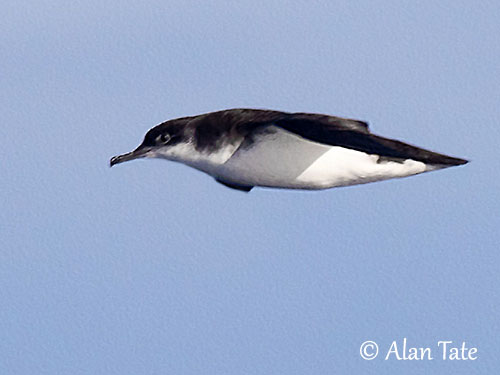
RANGE:
The Manx Shearwater breeds in N Atlantic on several small islands off Newfoundland (Canada) and Massachusetts (NE USA), S Iceland, S through Faeroe and British Islands to NW France, and in the south from Azores, through Madeira and Desertas Islands to Canary Islands.
Most birds winter off the east coast of South America, especially off Brazil and Argentina. It is an uncommon winter visitor off South Africa.
HABITAT:
The Manx Shearwater is entirely marine and comes to land only for nesting. The colonies are usually established on islands, both coastal and offshore islands, also on promontories, and often on steep, grassy slopes. They nest in burrows, often abandoned rabbit burrows.
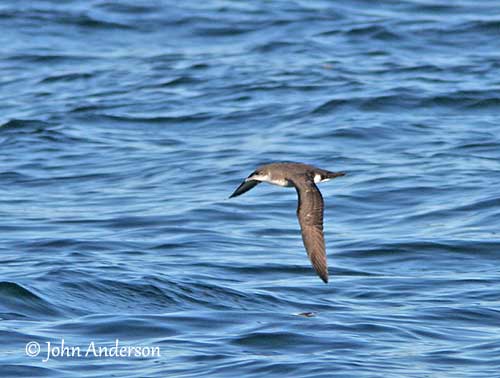
CALLS AND SONGS: SOUNDS BY XENO-CANTO
The Manx Shearwater is generally silent at sea. On the breeding grounds, it gives loud, raucous, cackling “cack-cack-cack-carrooo” or “keh-keh keh-kohrr” inaudible at distance. With much variation in pitch, the calls often sound squealing or howling. This species is very noisy at night in the breeding colonies.
The female’s calls are harsher than those of the male, and often less structured.
BEHAVIOUR IN THE WILD:
The Manx Shearwater feeds primarily on small fish such as herrings, sprats and sand lance, but it also takes squid and crustaceans.
It forages at sea over the continental shelf. It plunges into the sea from low flight, or also makes shallow dives from the surface, or seizes the prey on or just below the surface while swimming. This species swims very well underwater.
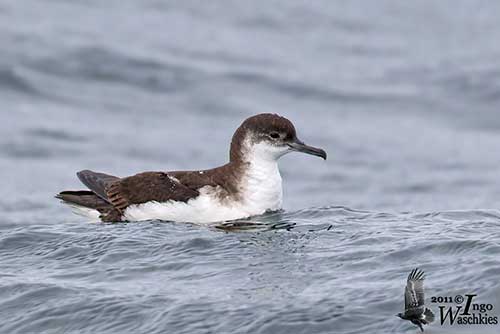
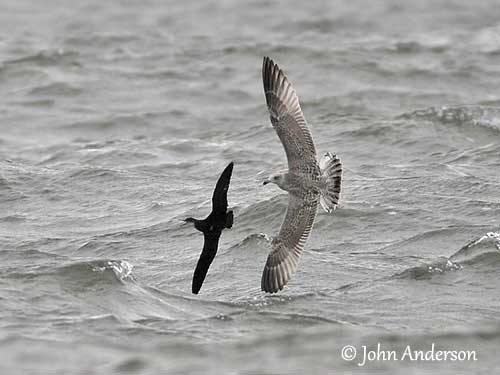
The Manx Shearwater starts to breed at 5-7 years old. These birds are monogamous and mate for life. They breed in large colonies established on islands.
The courtship behaviour is poorly known. Both mates usually spend most time in the burrow before the egg-laying. After mating, the female leaves the island in order to feed during several days while the egg develops in her. Both adults share the nesting duties.
The Manx Shearwater is a transequatorial migrant. It travels rapidly southwards in September/October, and returns in March. They often form rafts at sea.
Vagrants are recorded around Cape Horn and off S and C Chile, and in NE Pacific. The species is vagrant but very rare in Germany, Sweden, Estonia, Poland, Italy, Malta, Israel, Ivory Coast, Falkland Islands, Australia and New Zealand.
The flight is fast and close to the water, with series of rapid shallow wingbeats on stiff wings. This flight is followed by low glide while the bird is swinging from side to side.
It flies mainly by gliding with the wings flexed back in strong winds, and rises above the waves in shallow arcs.
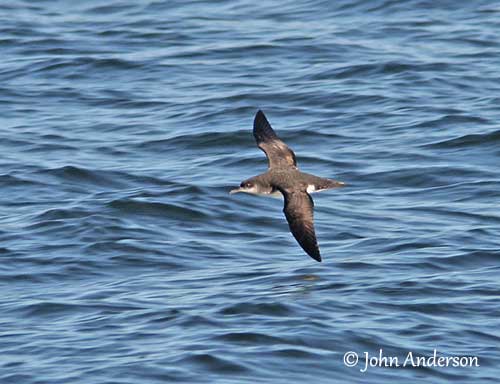
REPRODUCTION OF THIS SPECIES:
The breeding season starts in March when the Manx Shearwater returns to the breeding colonies.
After mating, the female alone leaves the colony to perform a pre-laying exodus during 2-3 weeks. The laying usually occurs in early May.
The colonies are established on steep, grassy slopes on islands. This species nests in burrows, often abandoned by rabbits or excavated by the birds.
The burrow may be used in several following years. The floor of the nest-chamber is lined with leaves and grass.
The female lays a single, large white egg. Both adults share the incubation, the male first, and then, the pair takes turns of 4-8 days, while the other bird goes to sea for feeding.
The incubation lasts 47 to 66 days, usually 51 days. At hatching, the chick has grey-brown down. Both parents brood and feed it. They abandon the chick after two months and the young goes to the sea alone 8-9 days later because it is hungry.
The birds always move at night to avoid predation by large gulls.
